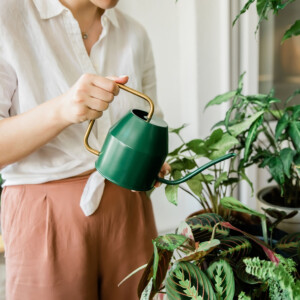Aside from adding a refreshingly natural touch to your interiors, indoor plants also help you save money. How do plants reduce temperatures? The answer lies in the additional layer of insulation which they create. This layer helps to maintain comfortable, cool temperatures by providing an extra level of protection from outside heat sources.
The cooling effect of house plants reduces energy costs and corresponding bills by lowering indoor temperatures. During the summer, they keep your home cooler and improve indoor air quality. By doing so, you can reduce your dependence on cooling devices that can breed bacteria and cause allergic reactions.
Heat Reduction by Plants: How Do They Work?
 A plant’s leaves release moisture into the surrounding air, which cools it and purifies it. It is estimated that by releasing moisture into a warm room it will lower the temperature by almost 10 degrees.
A plant’s leaves release moisture into the surrounding air, which cools it and purifies it. It is estimated that by releasing moisture into a warm room it will lower the temperature by almost 10 degrees.
By emitting oxygen and absorbing carbon dioxide, potted plants help remove harmful toxins and regulate humidity. Bringing greenery indoors helps to create a comfortable living space that keeps you cool and energized. When adding plants to your home, select ones that are well-suited for indoor living, only then will they help reduce heat and cut cooling expenses. Five to consider are:
- Ficus Benjamina. The weeping fig has foliage that helps to regulate temperature and humidity levels inside a home or commercial space, creating a cool oasis within the hot summer months. This hardy tree is resilient indoors, which makes it ideal for indoor spaces.
- Ficus Elastica (Rubber Plant). Improving humidity in an enclosed area has a cooling effect. This particular houseplant is effective at replenishing moisture in the air and increasing the overall level of humidity.
- Chinese Evergreen (Aglaonema). The English ivy has remarkable purifying capabilities, allowing it to purify toxins from the air. Its high transpiration rate also helps to increase humidity and make the environment more comfortable.
- Palms. Palm leaves have tiny stomata which take in carbon dioxide and release oxygen. Areca, Fern, Fishtail, and Lady Palms feature some of the largest surface areas for their leaves; as a result, they are capable of producing more oxygen compared to other plants with smaller leaves.
- Mother-in-law’s Tongue. The mother-in-law’s tongue, also known as the snake plant, is a great solution for keeping your home cool during hot summer nights. Its leaves contain high amounts of water that provide evaporated cooling when transpiring, not to mention its ability to provide oxygen as well.
Saving Electricity with Indoor Plants
The addition of indoor plants saves you money on your electricity bill by:
- Reducing the Pressure on Your HVAC Units: Indoor plants not only create a pleasant living space, but they can also help maintain your indoor temperature. Plant life within an enclosed space can regulate the air temperature no matter the season, but in the summertime, when temperatures soar, they can reduce the need to run HVAC systems as often. Continuing to run your air conditioner can add excessive strain to your cooling system. Reduce the load from these units by using indoor plants to minimize heat production as well as maintain reasonable temperatures.
- Improving Air Quality: Indoor plants have been proven to: reduce heat, improve air quality by filtering out harmful toxins, and eliminate the need for other electrical purification devices. All these benefits come naturally from adding a few plants to your home. Plants are an efficient and cost-effective way to reduce airborne dust and pollutants in your home. By adding a few plants, you can ensure the best breathable air – without the need for costly electricity-run humidifiers. So go ahead, get some greenery, and breathe easy!
Caring For Indoor Plants
Houseplants are easy to care for and make great additions to any home. Good lighting will help them thrive, so the best spots in a home tend to be near windows or on balconies. Not only do these plants improve interior décor, but they can also reduce heat, making them an excellent choice for all kinds of homes.
When caring for your plants, it is important to be mindful of shedding leaves. Pruning off yellowing or brown-tipped leaves can help the plant flourish.
It is also important not to over-water as this can damage the plant instead of nurturing it. It’s also just as important not to forget about your plants, especially when traveling, and not providing the water they need. Agway Energy Services customers won’t have to worry about over-watering again by requesting our self-watering plant spike. Simply add a clean beverage bottle, set the dripping speed, and you are good to go for a few days before needing to refill.